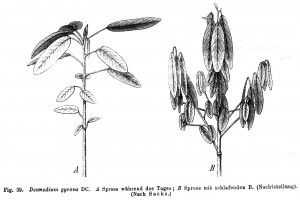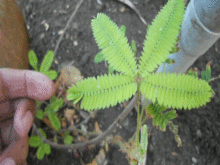Sometimes, when the beat drops, you can’t control yourself – you gotta dance! Turns out, this isn’t an exclusively human thing. Many animals have been observed moving in a rhythmic way, either to attract a mate or as a form of communication or to warn off predators – birds, dolphins, bears, dogs, squirrels, and honeybees, to name a few. You don’t need feet to feel the beat. One Asian plant can dance quite well while rooted firmly in place. This plant, the Telegraph plant, or Codariocalyx motorius, has made scientists re-examine answers to some basic questions about plant life. Can plants move? Can they hear? Can they remember? Can they learn?

First, a little bit about the Telegraph plant. It is found across Asia in China, India, Nepal, Thailand, Malaysia, and several other countries. It is a tropical shrub that produces tiny, purple flowers. It’s not the flowers, however, that get the attention; it’s the leaves. The plant has a set of leaflets, one larger and two smaller, that are attached by a hinge-like connector which allows the plant to lift and rotate the leaflets. It was given the name Telegraph plant because early scientists thought the rapid movement resembled a person sending out a telegraph. Subsequent observations of the Telegraph plant have lead researchers to re-examine their previously held concepts of plant life.
Can plants move?

The short answer is “yes”. While scientists first assumed that plants are incapable of movement, we now know that movement does occur, despite a plant’s lack of muscles. In fact, Charles Darwin’s last work, published just before his death, was the 1880 piece, “The Power of Movement in Plants.” Many plants are heliotropic, meaning they are able to move to orient themselves toward the sun. Some heliotropic flowers follow the sun’s movement across the sky each day. The plant does this, of course, to optimize its exposure to the sun’s energy. The “why’ was easier to discover than the “how”. Scientists have learned that the motion occurs in the motor cells in the plant’s pulvinus, a flexible segment below the flower. These cells are able to inject potassium ions into neighboring plant tissue, thus changing the turgor pressure so the cell walls push outward. The turgor pressure causes the cells to elongate, flexing and moving the pulvinus. Other plants, however, move differently than the heliotropic motion. These plants are capable of rapid plant movement to catch prey, spread seeds or pollen, or move leaves. The Venus flytrap (Dionaea muscipula) and the Waterwheel plant (Aldrovande vesiculosa), to name a few, quickly spring a hinge-like trap to capture prey. The Squirting cucumber (Ecballium agreste) and all species of the Trigger plant (Stylidium) propagate by rapidly dispersing seeds or pollen. The reason why some plants, like the Telegraph plant, quickly move their leaves is not as obvious. Darwin, in fact, couldn’t reach a definitive conclusion after his extensive study of the Telegraph plant. He hypothesized that the Telegraph plant was trying to shake off water droplets, but this idea is still debated.
Can plants hear?
 We all know someone who routinely talks to their houseplants or swears their garden produces better after daily conversation. And a middle school science fair wouldn’t be complete without an experiment growing one plant in silence and another to music. All this doesn’t mean, however, that plants can hear. They don’t have a specialized structure or organ for perceiving sound, like an ear. Plant research is showing us that plants are much more receptive to their surroundings that previously thought. Despite their lack of ears, plants can pick up sound vibrations through their leaves and will react to these sounds. And, to all the middle school science fair participations, research has shown that plants much prefer single note music to the complexities of Beethoven, Def Leppard, or Justin Beiber. In the case of the Telegraph plant, the plant appears to dance more to music than to talking or random noises. It even prefers higher pitched music.
We all know someone who routinely talks to their houseplants or swears their garden produces better after daily conversation. And a middle school science fair wouldn’t be complete without an experiment growing one plant in silence and another to music. All this doesn’t mean, however, that plants can hear. They don’t have a specialized structure or organ for perceiving sound, like an ear. Plant research is showing us that plants are much more receptive to their surroundings that previously thought. Despite their lack of ears, plants can pick up sound vibrations through their leaves and will react to these sounds. And, to all the middle school science fair participations, research has shown that plants much prefer single note music to the complexities of Beethoven, Def Leppard, or Justin Beiber. In the case of the Telegraph plant, the plant appears to dance more to music than to talking or random noises. It even prefers higher pitched music.
Can plants remember?
Without brains, plants cannot store memories like animals can, but they do seem to remember. One study, conducted by Monica Gagliano of the University of Western Australia, involved dropping and shaking a Sensitive plant (Mimosa pudica), a plant like the Telegraph plant that can rapidly fold its leaves when it senses danger. They study indicated that the plant remembered the motions done to it that were harmless and the unfamiliar motions that it could perceive as threatening. It is believed that the plant cells retained the “memories”.
Can plants learn?
If a plant can remember what has happened to it, can it learn from this experience? Surprisingly, yes. Studies, including Gagliano’s research, seems to indicate that plants use the memories of the past it has stored to modify its future behavior. The Telegraph plant will improve its dancing after repeat exposure to the same music. The more it is exposed to certain music, the faster its dancing becomes.
As scientists learn more about the Telegraph plant and delve deeper into the mechanics of all plant life, we are altering our understanding of what it means to be a living, intelligent, complex being. And we are beginning to see the lines between the plant and animal kingdoms blurring just a bit.
Sources
“Codariocalyx Motorius.” Blog post. Austin Botanicals, 29 Mar. 2014. 9 May 2017.
D’Amato, Peter. “The Telegraph Plant.” Blog post. California Carnivores. N.p., 28 Jan. 2016. Web. 9 May 2017.
Kim, Merri. “Can Plants Hear? In a Study, Vibrations Prompt Some to Boost Their Defenses.” Washington Post [Washington, D.C.] n.d.: n. pag. 6 July 2014. Web. 9 May 2017.
Krulwich, Robert. “Can a Plant Remember? This One Seems to – Here’s the Evidence.” Blog post. National Geographic, 15 Dec. 2015. Web. 9 May 2017.
Lowry, Connor. “The Dancing Plant (Codariocalyx Motorius).” Blog post. Weird and Unusual Plants. Growers Direct Fresh Cut Flowers. N.d. Web. 9 May 2017.
Featured image by Verde Canyon Railroad on Flickr.
